StephenVB
Industrial
- Mar 26, 2009
- 20
I'm curious about how a (not so) simple electro-mechanical turn signal auto blinker works.
The simple and incorrect answer, given by the how does it work sites, is a heater on a bi-metallic strip. This doesn't explain the blinker properties.
The blinker is in series with the load. A simple bi-metalic strip would have a shorter on time with more load (more current) and once open it would cool at a fixed rate so the off time would not depend on the load.
This would also delay the turn signal lamps while the bi-metal strip first heated up.
In fact the turn lamps are initially on and have shorter on and off times with less current (a single bulb instead of two).
Does anyone know how this actually works?
Thanks
Stephen Van Buskirk
A human being is a computer's way of making another computer. Yes, we are their sex organs.--Solomon Short (aka David Gerrold, US science-fiction author)
The simple and incorrect answer, given by the how does it work sites, is a heater on a bi-metallic strip. This doesn't explain the blinker properties.
The blinker is in series with the load. A simple bi-metalic strip would have a shorter on time with more load (more current) and once open it would cool at a fixed rate so the off time would not depend on the load.
This would also delay the turn signal lamps while the bi-metal strip first heated up.
In fact the turn lamps are initially on and have shorter on and off times with less current (a single bulb instead of two).
Does anyone know how this actually works?
Thanks
Stephen Van Buskirk
A human being is a computer's way of making another computer. Yes, we are their sex organs.--Solomon Short (aka David Gerrold, US science-fiction author)

